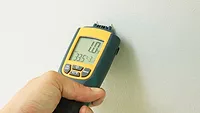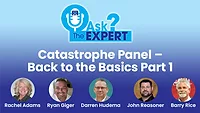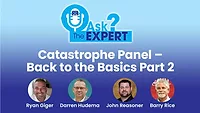BACK TO BASICS With Meters: A Professional Foundation
Moisture meters answer every important question in restorative drying. Do you need to know what’s wet? Use a meter. Are the materials drying? Get out the meter. How’s the air doing? Are the materials warm enough? Did the materials dry? Meter, meter, meter!
Thus the most important tool on the project is a meter. Without it, you know NOTHING! The meter in a professional restorer’s kit should be one of the most prized possessions, treated with gentle respect at every use and protected from every potential harm.
Pin-type meters measure moisture in materials. This is the most important reading. Pin meters should be your most preferred technology when holes don’t matter – such as in framing, and wet subflooring. Pin meters are more accurate and have fewer false readings than any other technology. Also, pin meters stay calibrated – I have never seen one go out of calibration in my 16 years in the industry.
Pin meters generally have a scale from 6 to 40, 60 or even 100. Meter kits typically come with several choices of probes, making the meters highly adaptable to a wide range of materials. The only limit to their use being the restorer’s creativity. Anything that conducts electricity can be used as probes – nails, screws, wires, and metal bracing – just as long as the two probes are placed apart on the material you wish to test. Pin meters work by measuring conductivity of wet materials and calculating moisture levels.
Pinless (non-penetrating) meters also measure moisture in materials. Pinless meters are almost as useful as pin meters, but not as trustworthy. While it is wonderful that no holes are made with pinless meters, restorers need to be aware of every quirk of their meter. Things you should understand about your pinless include:
- The exact location of the sensor(s)
- The depth it reads
- How it responds to different materials, especially dense materials
- The false readings it may produce
- How often should it be calibrated
Pinless meter manufacturers use all kinds of different scales for their meters. I have used meters with a scale of 0–20, others with a scale of 60-1000, and many other scales, too. But remember that the scale – whatever it is – doesn’t equate to a percentage of moisture content; it is only intended to indicate relative moisture content. Learn what your meter’s scale means, and use it consistently. And remember, the reading on your pinless meter is not a percentage of moisture content.
Thermo-hygrometers measure the temperature and relative humidity of the air. Hygrometers are important, just not quite as important as pin and pinless moisture meters. Why do I say that? Because hygrometers can’t easily tell a restorer when the material is dry, only that the air is dry. By all means, pick a sturdy, accurate and FAST hygrometer. Slow, inaccurate hygrometers cost you money in lost time and bad readings.
To get the most accurate readings on the meter, give it time to get acclimated to each new reading you take. Before you start your meter readings at a job, think about what readings you have to take. Which ones will be cooler? Hotter? Take the readings from cold to hot and you will save time. Always wait until temperature has stabilized before you note the reading.
Some dehumidifiers are equipped with on-board hygrometers. In my experience, these can be trusted as much as any other hygrometer. I am also in favor of using a smart phone to provide outside air readings – especially in cold weather. Just look it up on your favorite weather website. Both of these techniques can save you time.
Moisture sensors – the kind that beep or buzz when you poke them into carpet and pad – are great for checking where moisture is present and for finding urine spots. I can’t imagine not having one on a water loss call. But this tool is limited to use on carpet and pad only. If you use a moisture sensor for anything else, you should be beaten with a moisture sensor.
Thermal cameras show surface temperature differences. Thermal cameras are useful for every project manager. They are super helpful for finding water initially and for making sure nothing was missed toward the end of a job. Thermal imaging cameras are a great sales tool, because they visually show the customer where the problem is. Be careful, though, because there is a long list of situations where these devices can produce false readings. It takes some real skill to use them properly. They can tell you what is wet, but that’s all. If you are using a thermal imaging camera to prove a structure is dry, you should be beaten with a moisture sensor!
Laser temperature sensors are a super effective way to know if materials are warm enough to dry well. Really smart restorers I know use them every day for all kinds of cool stuff. Surface temperatures can indicate the potential for evaporation or condensation. They can tell you the temperature of the air coming though an HVAC register quickly. They are cheap, so get one and play with it and you’ll learn why you need it. Look at your current moisture meter – many newer models have laser sensor system integrated into the meter.
Boroscopes allow a restorer to look into a cavity through a small hole. This inspection tool keeps the smart technician out of trouble. Wouldn’t it be nice to know if there was mold in a wall cavity before you remove the drywall? Use your boroscope to confirm your suspicions before tearing out that wall.
There are many more meters we could talk about that touch restorative drying. Manometers, velometers and particle counters can be helpful to a restorer when the occasion arises.
As you can tell, I think about meters all the time. I’m not sure if that makes me a weird geek (and I’m not going to ask my teenage boys that question), but I am sure it’s an indication that I am a professional water restorer. What about you?
Note: Never hit anyone with a moisture sensor, it’s not nice.
Looking for a reprint of this article?
From high-res PDFs to custom plaques, order your copy today!







